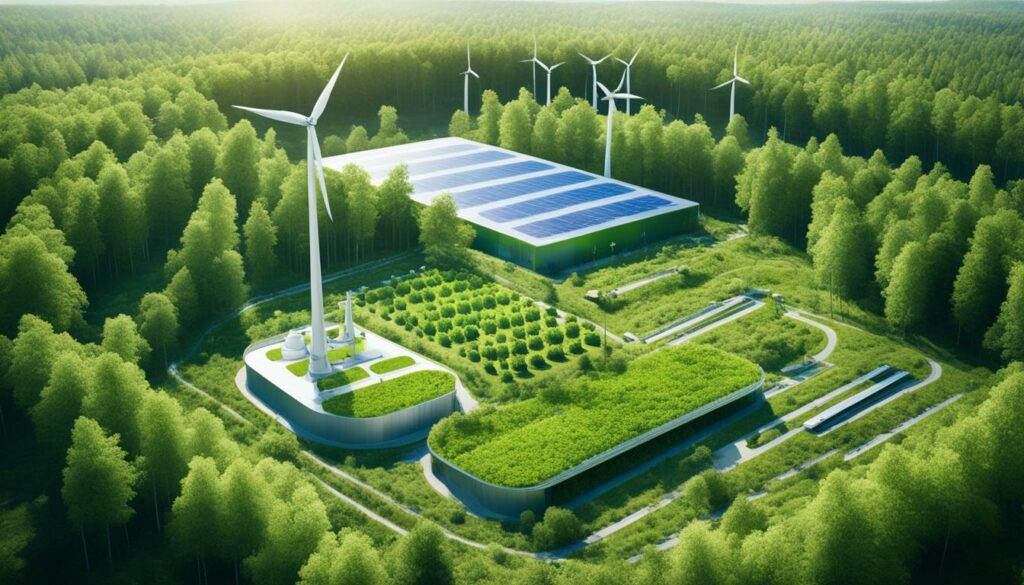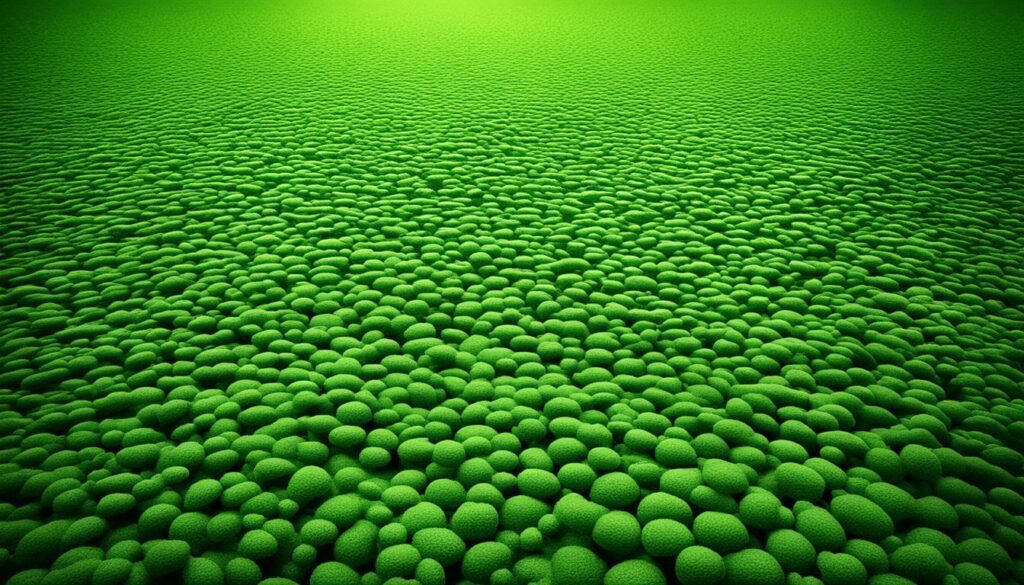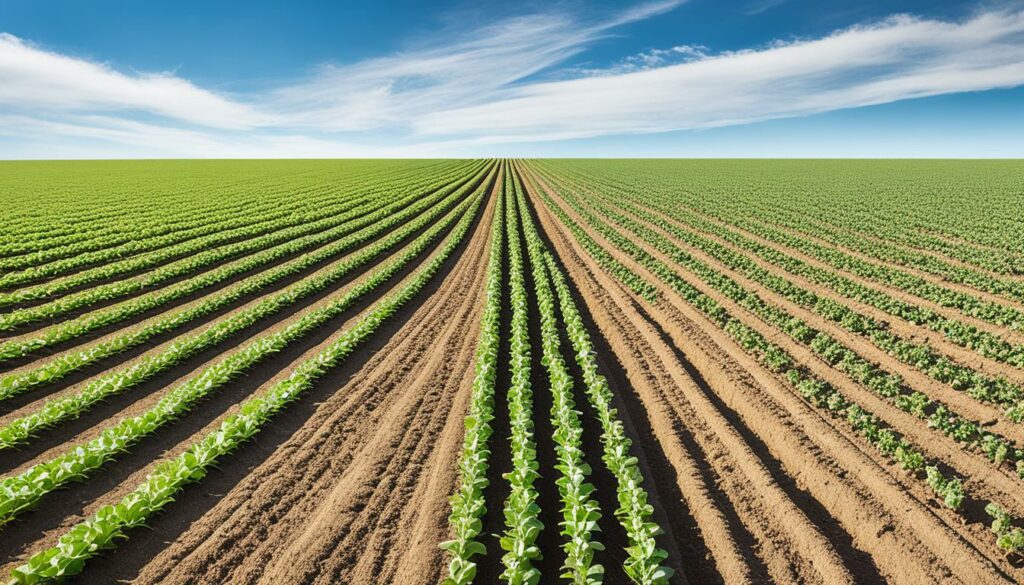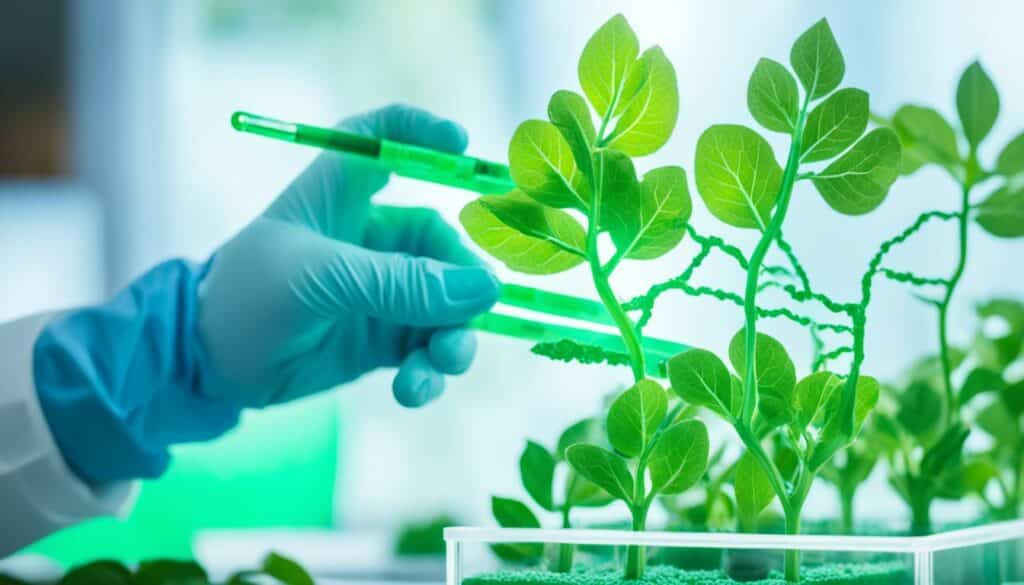Menu

Did you know that industrial biotechnology, which uses renewable sources, can help save energy? It also cuts down CO2 emissions significantly. This shows the huge role biotechnology can play in fighting climate change. Technologies like gas fermentation and making bioethanol have big environmental benefits.
Biotechnology covers many methods to understand and change the genetic makeup of life. It has become a key player in fighting climate change. It lowers greenhouse gases and promotes farming that’s better for the planet. The United States Department of Agriculture (USDA) sees it as essential for a sustainable Earth. It highlights that genetically modified crops can reduce food waste and trap more carbon. Also, these crops help prepare farms for extreme weather, making sure we have enough food.
Biotechnology is key in our changing climate. Our actions have increased greenhouse gases, leading to global warming. This change affects farming and food security deeply.
In agriculture, biotechnology is vital for making crops tough against bad weather. Things like wheat, corn, and soybeans have been made to survive droughts, aiming to make farming more sustainable and productive. There are also efforts to create livestock that can handle hotter temperatures. This work is critical for fighting climate change.
The United States is leading in using technology for smart farming. This work is very important because many people around the world rely on farming for their income. They are at risk from climate change.
By using biotechnology in farming, we can tackle major climate issues. We hope to keep making crops that can handle tough weather. This way, we make sure our food supply stays strong and reliable.
| Crop | Developed Traits | Benefits |
|---|---|---|
| Wheat | Drought-tolerant | Enhanced yield in dry conditions |
| Rice | Drought-tolerant | Improved water use efficiency |
| Corn | Drought and heat-tolerant | Adaptation to high temperatures |
| Cattle | Heat-tolerant | Reduced heat stress |
The environmental impact of biotechnology is a hot topic in agriculture. In the U.S., agriculture and forestry made up about 10.5% of greenhouse gas emissions in 2018. This shows the sector needs to change. Thanks to biotech, we now have crops and animals that deal well with tough conditions like droughts and diseases. For instance, there’s now drought-tolerant corn grown in dry areas of the U.S. and drought-tolerant wheat in Argentina and Brazil.
Biotechnologists are not just stopping at plants. They engineered cattle that can handle the heat better. This means less stress for the animals and more efficient use of resources. Solutions like these help tackle climate change. They boost farm output without needing a lot more land or water. This is key in lowering the environmental impact of farming.

Looking at the health sector, it too needs to step up its climate game. This industry made up 4.4% of all global emissions. When we compare the effect of big health companies to other sectors, the problem stands out. While some companies are doing their bit, most aren’t aiming for the climate target of keeping warming below 1.5°C. The carbon output of health biotech firms reached 227 million tonnes in 2021, up from the year before.
Better bio-technology and eco-friendly practices have a huge potential to help the environment. However, using these technologies widely brings its own challenges. It’s crucial to make solid commitments to fight climate change. We need ideas that are not only green but also work in the long run. This is the key to making biotechnology really boost our planet’s health.
Using sustainable practices in biotech helps fight climate change and lessens our impact on the environment. These methods include new technologies and smart ways to cut carbon emissions and save water.
Making and using biofuels is a top way to cut back on the biotech industry’s carbon footprint. For example, Global Bioenergies from France and Audi are turning wheat straw and wood chips into petrol. In 2011, biotech crops cut 37 million kg of pesticides, reducing CO2 as much as if 10.2 million cars were off the road.
Another key is growing better crops. The US approved a drought-resistant maize called MON 87460 in 2012. Such crops fight climate change and make farming more sustainable.
Saving water in biotech is urgent because of climate change’s impact on water. In Australia, since 2010, they’ve been testing genetically modified wheat and barley that can grow with saltwater. This could save fresh water for other uses.
Using biotech for water-saving crops and better wastewater management helps too. A company in Germany, Algalife, makes textile fibres with algae, sunlight, and water. They show how biotechnology can help save water in new ways.
Biotech innovations shine bright in our fight against climate change. They helped lower the U.S.’s agriculture and forestry’s greenhouse gas emissions by 10.5% in 2018. This progress is thanks to advanced biotechnology that’s improving farming to be more sustainable.

New crops like drought-tolerant corn and wheat are taking root in places like the U.S., Argentina, and Brazil. These crops fight the effects of climate change. Scientists aim to keep our food supply stable even in changing climates.
The U.S. is leading the world in making agriculture smarter and greener. It promotes both healthy farming and a healthier planet. A key example is editing cattle genes to help them stay cooler in hot weather.
In 2022, leaders in biotech aimed to make our environment and food better, according to experts from companies like Johnson & Johnson, Roche, and Bayer. They’ve brought us things like plants that resist stress, biodegradable soap ingredients, and a way to recycle plastic better.
Experts look at how many scientists want to learn about these innovations, what companies say about them, and how many people read about them. These measures show how much these new ideas matter. With over 8,000 innovations and 250 schools involved, the progress is clear.
Finally, sequencing the human genome now costs much less than in the past. From $95 million, it dropped to just $950. This huge price change shows the field’s dedication to making genetic research more widely available.
In all, these biotech breakthroughs are key to tackling climate change’s challenges. By striving to innovate, we aim to not just survive, but to flourish despite the hardships.
Biotechnology is at the vanguard of green innovation. It offers vital tools to fight climate change’s effects. We see this in everything from making energy to better managing our waste. These solutions show our push for a cleaner, greener tomorrow.
are a top option in fighting climate change. They come from organic waste and biomass, making them a sustainable fuel choice. In the U.S., these biofuels are cutting carbon emissions. This benefits both the environment and the rural economy.
Bioremediation is key in managing biotech’s environmental impact. It uses tiny organisms to clean up pollution. The USDA sees this as crucial for lowering emissions from farms and forests. It’s a big step towards sustainable waste handling and a healthier planet.
The link between green biotech and sustainable ways is vital. It’s helping us tackle climate change meaningfully. By using these renewable energy sources and managing waste better, we’re shaping a world that’s ready for the future. Bioremediation innovations and biotech are essential for solving environmental problems.
| Biotech Solution | Use | Benefit |
|---|---|---|
| Sustainable Biofuels | Energy Production | Reduced Carbon Emissions |
| Bioremediation | Pollutant Neutralisation | Cleaner Environment |
| Climate-friendly Waste Management | Efficient Waste Disposal | Less Environmental Impact |
Exploring how biotech helps fight climate change, it’s clear its role is vital. It aids in lessening climate change impacts, mainly in farming. The U.S. sees about 10.5% of its greenhouse gases come from farming (USDA-ERS). This makes moving towards eco-friendly farming a must.

Genetically modified corn in the U.S. and drought-resistant wheat in Argentina and Brazil show how we’re improving crops. These advancements help crops handle climate changes better. They can grow strong even when facing tough conditions.
Biotechnology is also key for making cattle that can handle the heat better. By editing their genes, we reduce heat stress and help cattle cope with hot weather. This protects the livelihoods of the many people worldwide who depend on farming. Animal breeders work hard to make different breeds tougher against varying climates.
Another big win for biotechnology is cutting down on herbicides and insecticides. In 2011, biotech crops led to 37 million kg fewer of these chemicals being used. This drop also means 23.1 billion kg less CO2, equal to the impact of removing over 10 million cars from the road.
Thanks to biotech, we have plants that can manage water stress. Crops like rice, maize, sugarcane, and wheat do well in areas with little water. Projects, such as the one to make maize drought-resistant in Africa, aim to do even more.
In the future, biotech will help plants handle extreme weather even better. The U.S. approved a type of drought-tolerant maize in 2012. There are also efforts to make crops that can withstand cold. These steps help keep farming sustainable and able to feed more people.
Agricultural biotechnology helps lead the way in creating a sustainable future. Using genetic engineering, scientists create crops that can survive droughts. Drought-tolerant corn grows well in the U.S.’s dry areas, and wheat can now thrive in Argentina and Brazil. These advancements help make our food supply stronger and more dependable.
Biotechnology offers several environmental perks. It lets farmers use less land and water, cutting down on greenhouse gas emissions. This is vital as in 2018, agriculture and forestry caused about 10.5% of these emissions. By growing genetically modified crops, we can reduce this impact and work towards greener farming methods.
Biotech also boosts the amount and quality of crops. In 2012, a high percentage of certain crops grown were genetically modified: 88% for corn, 94% for cotton, and 93% for soybeans. This shows the power of this technology. It has also reduced the need for harmful pesticides by creating plants that fight off insects and can handle certain herbicides. This means a healthier environment and better production methods.
Agricultural biotechnology has even brought about plants that can clean toxic soils. These plants make the land more fertile and sustainable. The USDA, EPA, and FDA work together to ensure these new technologies are safe for us and the environment.
For me, the future looks bright for agricultural biotechnology. As we use and develop these tools, we get closer to farming in ways that are good for the planet. This also helps us tackle important issues like feeding more people with less resources, especially as our population grows.
Below is a summary table displaying key statistics illustrating the impact and adoption of agricultural biotechnology:
| Key Statistics | Details |
|---|---|
| 2018 U.S. agricultural and forestry greenhouse gas emissions | 10.5% (USDA-ERS) |
| Biotech crop adoption in 2012 (U.S.) | 88% corn, 94% cotton, 93% soybeans |
| Drought-tolerant crop examples | Corn (U.S.), Wheat (Argentina, Brazil) |
In conclusion, agricultural biotechnology is key to making our food systems more sustainable. It helps reach goals for the environment and food security.
The need for drought-tolerant crops is high. They are key to keeping food supplies stable worldwide. As the climate changes, droughts get worse. But, biotech is helping create tough types of wheat and maize. These can grow well in dry areas.

Wheat and corn, especially, have done well in dry periods. Between 1980 and 2015, global wheat and maize crops fell by about a fifth and two-fifths, respectively. This was due to climate changes. But, new crop types cope better with less water.
For example, DroughtGard® maize cuts down on loss in places short on water. This has helped ensure food for many people.
Drought-tolerant crops are very important for our food worldwide. If we don’t act, droughts might halve crop harvests in 50 years. But, the new crops are changing things. They keep food supplies stable. This helps not just feed people but also support economies. This is true in places like Liberia, where farming is a big part of the economy.
About a fifth of the world’s farming land is too salty. And this salinity is getting worse. Here, too, these new crops are a green solution.
More than 750 million people faced severe starvation in 2019, underscoring the urgent need for resilient agricultural solutions.
Biotech crops are crucial for food security. They make our farms stronger against tough weather.
Biodiversity conservation with biotechnology changes the game in protecting ecosystems. It uses technology to study and alter organisms’ genes. This guards against the loss of different genetic types, critical for ecosystem health.
Preserving ecosystems with biotech tools is key. They help keep species and their homes safe, keeping genetic diversity alive. Because worldwide farming is turning to biotechnology, it relies less on old farming ways. This shift directly helps keep our planet’s ecosystems sustainable.
GM crops have cut the harm caused by usual farming a lot. For example, plants that resist insects have made the world use 37% less insect poison. This has made more types of insects call the farms home, which is good for ecosystems. They’re now healthier and last longer.
Also, GM crops let farmers grow more food on the same land. This means less need to cut down forests for farmland. By growing efficient plants like corn and soybeans, they’ve also stopped a lot of greenhouse gases. Without these special crops, we’d need to farm more land, destroying even more nature.
The table below shows how GM crops help the environment and save nature:
| Impact Area | Statistics |
|---|---|
| Reduction in Pesticide Use | 37% decrease globally |
| Reduction in Herbicide Use | Decreased acute and chronic toxicity |
| Land Use Efficiency | 0.15 Gt greenhouse gas emissions saved |
| Biodiversity Preservation | Higher insect biodiversity observed |
CRISPR has changed the game in plant science. Since 1850, global temperatures have risen by nearly 1°C. This warmed up the planet and made plants face new challenges. Hence, tools like CRISPR/Cas9 are very important for making better plant types. These types can survive extreme events like droughts, floods, and attacks by pests.

Global warming is making it harder to grow crops in some places. For example, between 1981 and 2010, the amount of corn, wheat, and soybeans we grew went down. This proves we need new ways to keep our crops healthy. Gene editing can help without making the crops GMOs. It can make changes to crops that allow them to live through hard times without harming the environment.
Crops improved through CRISPR in agriculture are doing better than before. They produce more food and are healthier to eat. These crops can even help fight climate change by absorbing carbon dioxide. By 2050, about more than 1/5th of the land used for crops might be too salty to grow food. This is where editing genes is a big deal. It helps make crops stronger so that we can still grow food even in difficult places.
Studies show that gene editing can help us stop the bad effects of climate change on farming. In hot places like Africa and Asia, a rise in temperature could reduce food by up to 35%. Gene editing can make plants that survive this heat and keep feeding us. This shows how important CRISPR is in our new ways to make the food supply strong and steady.
In today’s world, agricultural challenges from climate change are more evident. Animal biotechnology stands out as a key player in adapting to climate change, especially in animal breeding. With new genetic skills and breeding choices, we’re creating heat-resistant livestock. These animals can handle hotter weather without losing productivity from heat stress.
Scientists have really moved forward in making animals that can handle heat better. They add genes that help animals deal with hot weather. Thanks to agricultural biotechnology, there are cows, for instance, that can better control their body temperature when it’s hot. This not only helps the animals, but it also keeps the farming business running well.
Dealing with methane emissions from livestock is also very important for the environment. This gas is a big part of the problem with global warming. But thanks to animal biotechnology, we have smarter ways to lessen this impact. By using new genetic tricks and better farming methods, we can make livestock produce less methane. This effort helps address climate change while making sure we can still feed everyone.
| Key Focus | Details |
|---|---|
| Heat-resistant Livestock | Development of animals with improved heat tolerance through genetic modification and selective breeding. |
| Reducing Methane Emissions | Application of biotechnological advancements to reduce methane output from livestock, contributing to lower greenhouse gas emissions. |
In our push for a greener future, advanced biotech methods are key to cutting greenhouse gases. Using microbes to capture CO2 is a great example. In 2018, farming and forestry made up about 10.5% of U.S. emissions. Using special microbes to catch CO2 from the air can help lower our carbon footprint and make the planet healthier.
Microbes are great at capturing carbon. Now, scientists have made bugs that soak up CO2 and change it into something useful. For instance, there’s a bug that turns CO2 into a key chemical, reducing emissions. This method isn’t just good for the planet; it also works well with green energy systems, like those in Brazil.
There are also new ways to grab carbon from the air and store it. These methods mix science and nature to remove emissions. One cool technique is to use tiny bugs to make materials we need from CO2, cutting pollution in the process. These steps show the power of biotech in making our world cleaner and more sustainable.
Biotechnology helps fight climate change by making crops that can handle bad weather. It also promotes farming that’s good for the environment and cuts down on harmful gases with biofuels.
Innovations in biotech include GMOs that are tough against climate stress, and synthetic biology to change living things. Technologies like CRISPR/Cas9 are also used to make better crops and get more food from them.
It boosts the amount of food by making crops and animals that can survive tough weather conditions. This keeps our food systems stable even when the climate is changing.
Biotechnology has two faces for the environment. It helps cut down bad gases and saves resources. But, some worry about what these technologies might do over a long time.
Sustainable biotech ways include making biofuels and using carbon-capturing farming methods. They also help make crops that don’t need as much water, saving resources.
By studying and changing genes, biotech helps save species and their homes. This work is vital in keeping a variety of plants and animals around.
Biotech is key in making crops like wheat and corn tough against lack of water. By changing their genes, we get plants that are stronger and give more food even when it’s dry.
Biofuels come from natural materials and waste. They are better for the planet than fuels from oil. Using them can cut down the gases that cause climate change.
CRISPR/Cas9 is a tool for making plant genes better. This means we get more food from the same plants, they are healthier and need less pesticide. It makes plants strong in the face of climate changes.
To make animals that can take heat, we change their genes and pick the best to breed. We’re also looking at ways to cut down on the gas they make, which makes the planet warmer.
Yes, it can by using tiny living things to grab and store carbon. This can be done through making gas or using other biological ways to keep carbon from the air.
By making crops that use less water and finding better ways to deal with dirty water, we can save water and cope with climate change. These methods are good for the environment and people.
Bioremediation uses living things to clean up pollution. This makes a cleaner place for biotech work that’s safe and helps the environment.